|
|
Le Corbusier. When the Cathedrals Were White. — New York ; Toronto ; London, 1964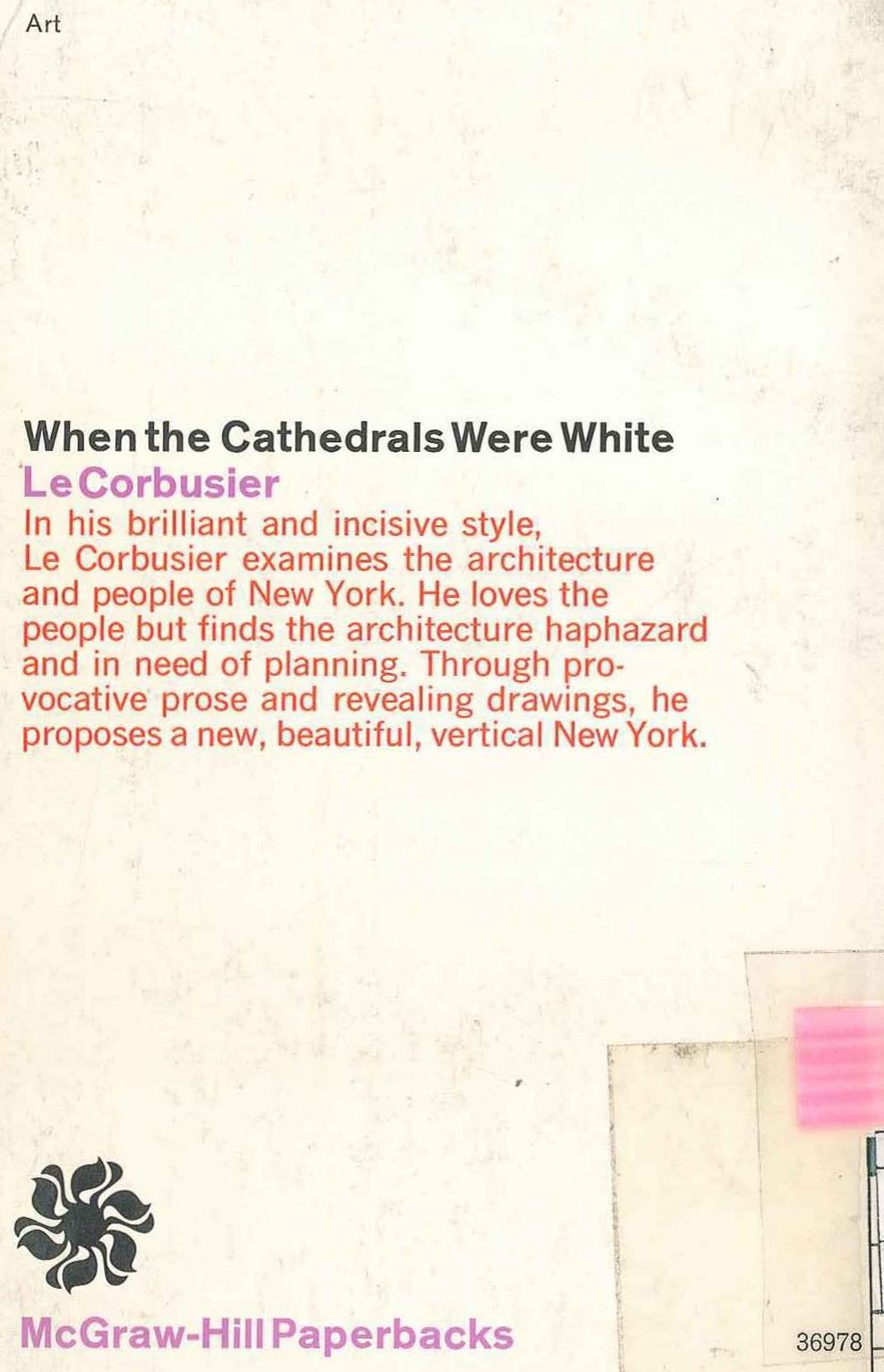 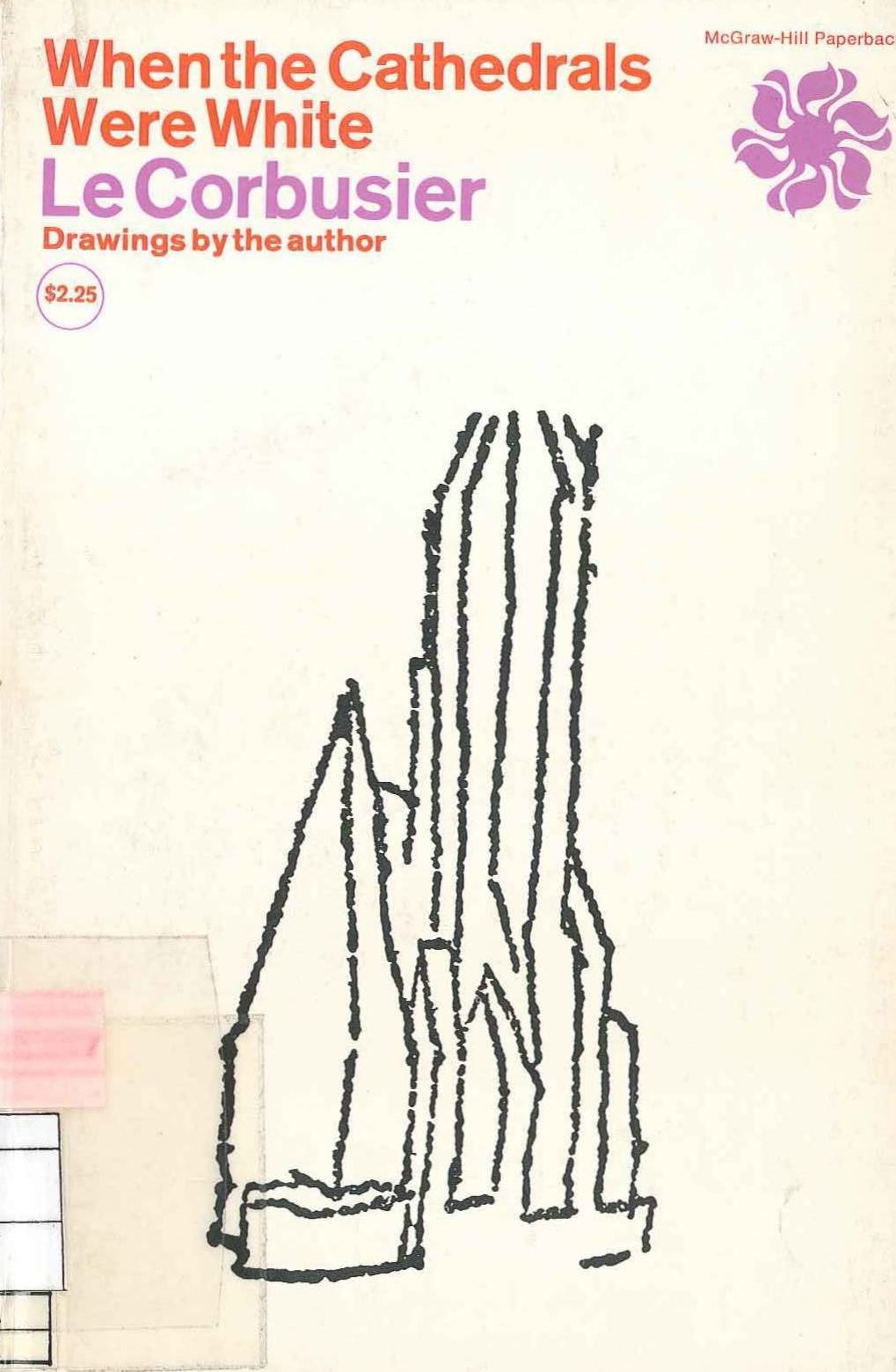 When the Cathedrals Were White : Drawings by the author / Le Corbusier ; Translated from the French by Francis E. Hyslop, Jr. — New York ; Toronto ; London : McGraw-Hill Book Company, 1964. — XXII, 217 p., ill.
For nearly sixty years Le Corbusier, along with Frank Lloyd Wright and Walter Gropius, has been in the forefront of modern architecture. In this book the distinguished architect focuses on American architecture, its ugliness and charm.
In his brilliant and incisive style, Le Corbusier examines the architecture and people of New York. He loves the people but finds the architecture haphazard and in need of planning. Through provocative prose and revealing drawings, he proposes a new, beautiful, vertical New York.
INTRODUCTION TO THE AMERICAN TRANSLATION
The American Army, arrived in Europe, found its lands, its peoples, its cities, and its fields ravaged by four years of war, emptied and robbed, in ruins, covered with dirt and eaten with rust; found broken windows and nerves on edge, exhausted bodies and tenacious morale. American aviators had bombed everything, blowing up bridges, stations, railroads, factories, ports. There was no wax for the floors, no paint for rooms and houses, no soap to wash with. In the Paris subway, the only means of transportation for five million persons, faces were green from privations. And in Paris (it was only known afterward) the Germans had executed seventy-five thousand men and women, after having tortured them.
On the day of liberation a portion of the armies of the USA and of Leclerc's army passed through Boulogne-sur-Seine, the suburb of Paris in which I was living. A terrible hour to live through, feelings in tumult and tears in our eyes. A spectacle: those men, boys from the United States on magisterial machines, twenty-year-old boys who had just beaten the enemy. Near them, Leclerc's soldiers who had come from Lake Chad, having crossed the Sahara; tomorrow, in a single bound, they would move on to Berchtesgaden; engraved on their faces they bore the tradition of two thousand martial years. The women of the suburb, like those in all of Paris, had dressed in their prettiest in anticipation of the liberation. They were adorned with smiles and joy. The women of Paris had been extraordinary: without dressmaking materials, without means of maintaining their customary elegance, they managed the trick of being desirable; without hats, they had invented ways of turning their hair into gold, bronze, or ebony helmets, a warlike coiffure which made them luminous and magnificent. Feminine centaurs on bicycles cutting through the fog of Paris in the springtime or in the dog days, legs, hair, faces, breasts whipped by the wind, indifferent but disturbing, they passed under the noses of the sinister-purposed, drearily colored "green mustard" soldiers....
They climbed up the American tanks; they kissed the Americans, leaving lipstick on dusty cheeks; they sat down beside the crews and drivers. Alas, they were taken for whores!
The children, naturally, were on the guns, on the turrets, on the knees of soldiers. Many asked for cigarettes. Some of them were greedy. The soldiers called the French beggars! For four years they had had only two or three packs a month, which is more tormenting than not smoking at all. If the authorities had had the courage, they would have simply cut off tobacco. After two months of annoyance everyone would have been free of that nagging desire.
O Americans, soldiers of the United States suddenly landed on morally and physically exhausted countries, on countries where all goods had become ersatz, controlled by nearly worthless ration points, in physical misery and shabbily dressed, to you, accustomed to unheard-of abundance and frightening waste, Europe—the great country of your fathers—seemed dirty, cut to pieces. Mad with joy, Europe welcomed you; you thought her indecent!
In the United States your cities are strong and rich. New York is the home of some god of modern life; a perhaps still nameless god. Your towns are painted with white and with intense colors; they have no confining walls: the lawns extend from house to house like a luxurious carpet under well-kept trees.
You were astonished, you were shocked: "Is this Paris, is this Europe?"
Coming from the south on the same day of liberation, Leclerc’s tanks, moving in a direction opposite to that of De Gaulle’s procession, went up the Champs Elysées, on the heels of the enemy. On the sides of the tanks supplied to our army, in large, freshly painted white letters, were names of French provinces (France was being liberated by the minute!!!): Brittany, Provence, Flanders; names of the great of France: Vercingétorix, Bayard, Joan of Arc, Lafayette; names of French qualities: courage, valor, fidelity....
On the occasion of this hasty passage before the Arch of Triumph, and for the sake of dignifying the taking over of this magnificent machinery of war by sans-culottes, you were right, leaders, in thus affirming essential values. And you were right in organizing the march past the arch of triumphs, where the tomb of the unknown soldier is placed. The tomb is immaterial architecture except for a flame and a dedication on the level of the ground. A monument reaching the scale without any possible measure of the ordeal endured. When, in this book, the white cathedrals are called up as witnesses on the side of modern times, this monument takes an unrivaled place; it reveals the spirit. Who imagined it? Who suggested it? I do not know; it is not known; I believe that no one (or very nearly) yet knows.
American friends, among those of you who have spent some time in France there are some who have entered more deeply into French existence. You have knocked at certain doors and found plain men who, through forty years of effort, or thirty, or twenty, have brought spirit into the world, have made the buds of the present mutation bloom: the artists, the great artists who, in the millennial humus of Paris, have caused the germination of the great metamorphosis which can make radiant tomorrows.
Some of you went to these men as fervent friends. But others were autograph hunters.
The authorities (yours and ours), feeling how necessary it was that we know each other, exchanged smiles and gestures of courtesy. American students were enrolled in France and French students in America. Intellectual exchanges. Who controlled them? God or the Devil? Life or the Academy? I know American students of painting and architecture placed in the big schools who said to me: "We went through that once and that is enough!" The time they spent in other parts of the city, fortunately, will bear fruit.
Academy—Life, that is the question! That remains the question in the USA as in France, as in the whole world.
Life creates and destroys; it gives birth to the temples of India and also to the creeping tropical plants which will loosen stone from stone in the work men have failed to guard.
Life has made New York, "a vertical city." And with joy we have saluted this city of life.
The skyscrapers are high. Here height is an automatic result of mechanical calculation, of the financial balance sheet, and of publicity. Between the ground and the top of the skyscraper spirit was not called in, but only number. You must look at the top, seek the intention, see what the spiritual reality of the enterprise is. The top is the cork of the bottle that architecture and architects have fashioned with care. As examples I see three of them before me, against the sky. One reproduces the Château of Blois in Touraine; another was inspired by the Sainte Chapelle; the third has the slate, roof, and chimneys of Fountainebleau. Ugh, ugh! Take care that that spirit, misusing height, money, and publicity, does not Iay claim to the leadership of the spiritual destinies of the USA!
On Sunday the city ceases to be anything, the streets being empty and the buildings deprived of their meaning (except for Rockefeller Center and several others in which there is architectural life). Sunday is an astonishing touchstone which, for twenty-four hours, can cause the collapse of this magnificent city which, in its essence, is still a Babel.
In contrast, in other places where life seeks nourishment, honky-tonks and juke box joints, in Harlem and on Broadway, laughing jazz rises to the attack....
Men of the United States, you are Americans, and Americans are all the peoples of the world; and this world can be the new world crowning the New World.
Before the war, all the editors who considered the publication of Marguerite Tjader Harris’s skillful and intelligent translation of Quand Les Cathédrales Etaient Blanches (published in part in issues of Direction, 1938, 1939), had insisted on dropping the first fifty pages, which have to do with France. Since then your armies have been among us and, naturally, the first fifty pages will remain in this new translation. Between the lines you will discover the premonitory symptoms of a defeat. There was a menace; there were deadly germs; there was the dangerous academic spirit.
In Paris, in this spring of ’46, sap is circulating in hearts and heads. Do you think that such an ordeal has made such a country bow? A squaring of accounts is in process; there a debate about the reasons for living has opened. The long ordeal was an irresistible ferment: heads and hearts acquired energy in going through it and, since the core of the sickness has heen struck down, there is a passionate will to climb up as high as possible.
In six years France has gone through a pathetic cycle. She is preparing herself to choose, to determine, to decide; but wavering steps may continue. We do not lightly enter such new paths!
When I was invited to come to the United States for the first time, by the Museum of Modem Art, I was considered the man of "the machine for living" and also as the man who had said: "The skyscrapers of New York are too small." It was held against me, I was treated a little coolly.
Ten years have passed. The misunderstanding is disappearing; understanding seems to be growing; our positions are becoming stabilized, as when the water has risen in one side of a lock: the levels are equal, the gates open, the ships pass through, ideas circulate.
The American potential which has sprung up in the course of the century, which has drawn an unimaginable profit from the two wars, is an event overflowing and exceeding the present limits of material and moral control, just as, at the other end of the world also, in the USSR, an equally powerful but different potential has begun a series of events whose repercussions are unpredictable. Thus far neither the one nor the other of these forces is clear-sighted; they are quite simply on the march, getting under way. And, on the march, they commit and will commit excesses, just as they bring and will bring all the reasons for hope and all the proofs of efficacity. Nevertheless they roll on, and through lack of adjustment, they cause paradoxical results, specific maladies, dangerous fevers.
Thus, for instance, the detestable gift of unlimited means of transporting people and ideas: mobility turned into a disease, a disease that might be called m-o-b-i-l-i-t-i-s,—mobilitis.
Everything rolls here; motors roar on water, on highways, on railroads, and in the air; men are on wheels; they have wheels under their bottoms and thus they transgress the law of nature—of human nature, which is eminently alternating and not continuous: footsteps, the beating of heart and arteries, the closing of eyelids, the breathing of the lungs and the formulation of speech, etc. . . . For the philosophic spectator, the end of the road quickly appears: as things are, the cycle of the actions of life is not carried out, or not fully, or with pain and loss, in the irremissible period of time of each day. That is the judge, that is the touchstone: daily life. And here is the verdict: incompleteness, dissatisfaction, injury written into the overcrowded solar day, recurring each day and impoverishing each day, and consequently into the whole life of men. The family torn apart, a kind of alcoholism, are among the elements in the vague outline which surrounds the unfolding of this drama.
How to live? The problem does not exist in countries that are unaware of it, but only for those who see clearly. And it is the binomial equation individual-collectivity which requires an effective, radiant harmony. The limits of freedom have to be determined, though fixing limits may seem necessarily to strike out freedom, which is not the case. The liberties of some, like the intangibility of certain principles, are becoming objects of discussion and examination. Indeed, the disorder is evident throughout American life in what in '35 I called "The Great Waste." The word waste could be associated with the French term emptying. Applied to social life, emptying is a disaster, a death march. At the present time, and especially in America, it appears in the form of four daily hours of slavery demanded of everyone in order to pay the costs of urban chaos.
Knowing how to live is the fundamental question before modern society, everywhere, in the whole world. An ingenuous question and one that could be considered childish. How to live? Do you know how, reader? Do you know how to live soundly, strongly, gaily, free of the hundred stupidities established by habit, custom, and urban disorganization?
If this book had to wait ten years for an American publisher, I should like to be able to congratulate myself about it, since on my return from the USA in 1936 I realized that it was necessary to invent a sign which might serve as a guide, as a Table of the Law. Then, in 1937, in the center of the Pavilion of the New Times at the International Exposition of Arts and Techniques, on a table dominated by the large open book which set forth the Charter of Athens of the International Congresses of Modem Architecture, I had this sign painted:
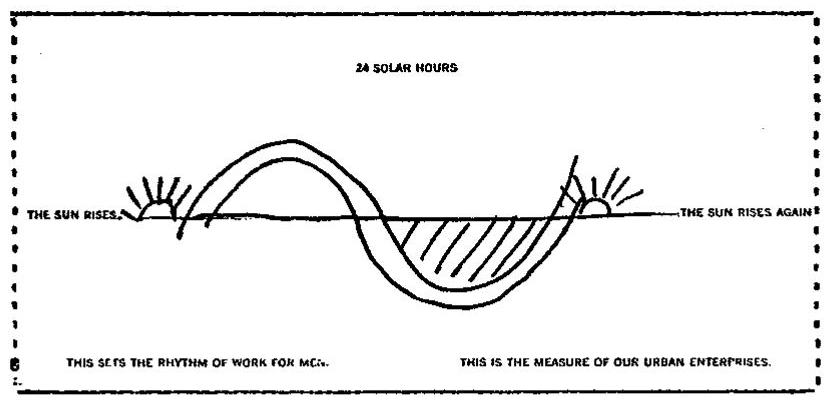
and had this statement inscribed: This is the measure of our urban enterprises.
If, in the course of the mutation of machine civilization, I have been able to contribute something, as a person with some rationality and intelligence, as a technician, as a thoughtful man, it will be this sign.
If I can be useful in some way to the United States now, it is in commending this sign to the meditation of those whose mission it is to see clearly and lead. I offer this sign as a measuring instrument which can give the right dimensions to the new centers of production developing from the reconversion of war industries: the substance of society, with all its rights and duties, is being taken up into our hands again. I know that here I am on the essential theme, the great modern theme: HABITATION, knowing how to live in a place. Habitation is life, knowing how to live! How to use the blessings of God: the sun and the spirit that He has given to men to enable them to achieve the joy of living on earth and to find again the Lost Paradise.
To whom am I speaking? To whom it may concern. Who is concerned...? That is the usefulness of books: they go out and find those who are concerned. Someday, behind the Americans, the youth of the whole world will decide!
City planning (city planning and architecture are inseparable from one another, they make up a single phenomenon) is the social organizer par excellence.
About 1935 the work of the TVA was begun. In January of this year, '46, I went to see its effects. Man and nature, laws of nature and calculations which also express the laws of the world, human imagination in search of harmony . . . Neglect had unloosed catastrophic events in the valley. Things were going from bad to worse. Nature was taken by the hand and finally her anger was calmed; once again she became maternal. The cyclic flow of water brought about a wonderful regeneration; men found again abundance and the promise of joy. And also, in mastering nature, they felt pride in having created the great dams which are bearers of physical and spiritual splendor.
Ten years were enough to bring about the appeasement of hostile forces and the alliance of man and his setting.
I am writing these lines in New York where I arrived twenty hours after leaving Paris. Sometimes, from a great height, I saw a gigantic iceberg in the dark blue ocean, a witness of physical realities and a segment of a regular cycle.
Man, nature, cosmos, those are the given elements.
One day (a hundred years ago), man went from the immemorial speed of walking to the unlimited speeds of machines. Everything was called in question. The limits of control were torn away, extended to the point of disappearing. But the sun, imperturbable in its course, continued to mark the rhythm of our work. Today it accuses us of confusion, lack of foresight, neglect, heedlessness; misfortune and the worst kind of disproportion are the result.
In January of this year I came, here in nineteen days, through storms, in an empty freighter, in order to carry out a small mission with Claudius.
When we arrived in Manhattan, pilgrims who had gone through years of grief, affliction, frustration, we experienced a frightful shock: the collision of people who cannot really bring together the things they have lived through—ours, sad ones, theirs, extravagant abundance. Thus, the merchandise that we bring today cannot be taken from the stock of the miseries we have gone through; it can be only constructive discovery, clear, rational, representing our proposals for the future—the wise future of machine society in search of its welfare ... lost but recoverable and discoverable before us, in the future, in an immediate tomorrow. Geography speaks, then: USA and USSR; at the geographic and historical heart: Paris, capital of a France fortunately well rooted in her own soil, the eye (on the map) of a united Europe. Today this third trip to New York gives me the impression and the certainty that the earth is round and continuous and things contiguous. A master unity will be established.
We French, then, who have had the cathedrals and Louis XIV, can admire the prodigious work, which is still in process of birth, accomplished by the people of America. Humbly I take off my hat. Night or day, at each step in New York—a fairy catastrophe—I find pretexts for reflection, for mental construction, for dreams of extraordinary, cheering, happy tomorrows near at hand. There is hope in the world. With full hands this country of the timid people gives us causes for hope.
I am one of a commission whose task is to find a permanent site for the United Nations in the neighborhood of New York. Harmony is the purpose of the United Nations. Harmony will be achieved by making organizational effectiveness (or efficiency) secure along with respect for the individual human being—more than that, by bringing the joy of living into being through wise city planning, a science which today is becoming a key, the key.
As yet no one knows surely whether or not such an affirmation is tenable, and still less whether or not it is the means by which the men of the second period of machine civilization, after having acted like gangsters and madmen, will set their house in order again.
LE CORBUSIER
New York, May 21, 1946.
PREFACE
This book also¹ will be full of tumult because the world today is full of tumult, because everything is unchained.
____________
¹ "La Ville Radieuse," published in 1935, has to do with the equipping of machine age civilization in the city and in the country. That book is the fruit of fifteen years of work; it is dense; it is like a cellar filled with every kind of food. I have been reproached for it. Even today I am unable to preside over a polite drawing room where etiquette is queen.
It is noon on a summer day; I am driving at full speed along the quays of the Left Bank toward the Eiffel Tower, under the ineffable blue sky of Paris. My eye fixes for a second a white point in the sky; the new tower of Chaillot. I slow down, I look, I plunge suddenly into the depths of time: Yes, the cathedrals were white, completely white, dazzling and young—and not black, dirty, old. The whole period was fresh and young.
...And today, yes! today also is young, fresh, new. Today also the world is beginning again....
I have just returned from the USA. Good! I am going to show through the USA, taken as an example, that the times are new, but that its living quarters are uninhabitable. The table has not been cleared after dinner; the remains of a banquet have been allowed to lie in disorder after the departure of the guests: cold sauces, picked bones, wine spots, crumbs, and dirty silver scattered about.
The cathedrals belong to France, and Manhattan is American. What a good opportunity to consider this fresh, twenty-year-old city against the background of one’s awareness of the skyscrapers of God. This new place in the world, New York, examined by a heart full of the sap of the Middle Ages. Middle Ages? That is where we are today: the world to be put in order, to be put in order on piles of debris, as was done once before on the debris of antiquity, when the cathedrals were white.
Nevertheless, before opening the window on that landscape of time, I shall first have you breathe the exhausting atmosphere in which we are struggling. The pages about the USA will be, rather than a narrative, the considered reaction of a man lifted up by hope for times of strength and harmony. Today, finally, in the history of the world, the page turns.
Paris, June 1936.
CONTENTS
INTRODUCTION TO THE AMERICAN TRANSLATION xi
PREFACE xxi
PART ONE — ATMOSPHERES
1 GREATNESS OF THINGS 3
WHEN THE CATHEDRALS WERE WHITE 3
2 DECADENCE OF THE SPIRIT 10
NEWSPAPERS 10
MONEY 11
SAINT FRONT OF PERIGUEUX 13
BORDEAUX STATION 15
CONDITIONED AIR 17
NEVERTHELESS, THE MUNICIPAL COUNCIL RESERVES THE RIGHT... 21
3 NATURE OF THE TRUE 25
GREATNESS IS IN THE INTENTION 25
PART TWO — U. S. A.
PROLOGUE 28
1 CITIES OF THE WORLD 29
INVESTIGATOR OF THE SITUATION 29
MOTIVE OF MY JOURNEY 33
NEW YORK, A VERTICAL CITY 36
2 I AM AN AMERICAN 39
"I AM AN AMERICAN" 39
NEW YORK IS NOT A COMPLETED CITY... 44
IT IS A SAVAGE CITY! 46
THE STREETS ARE AT RIGHT ANGLES TO EACH OTHER AND THE MIND IS LIBERATED 47
THE SKYSCRAPERS OF NEW YORK ARE TOO SMALL! 51
THE SKYSCRAPERS ARE GREATER THAN THE ARCHITECTS 59
IN THE CELLARS! 61
SOMETHING WHICH HAS BEEN ACCOMPLISHED 67
A MILLION AND A HALF CARS DAILY 68
THERE ARE NO TREES IN THE CITY 71
A REMARKABLE ARCHITECTURAL SIGHT 73
A PLACE OF RADIANT GRACE 74
BROOKLYN BRIDGE 76
GRAND CENTRAL TERMINAL 78
SUBURBAN TRAINS 80
THE FAIRY CATASTROPHE 83
3 PRANCE —AMERICA 92
YOU ARE STRONG 92
PRIDE 95
IS IT A CANCER? 100
A BUSINESS LUNCH AT THE PLAZA 103
A BUSINESSMEN’S DINNER IN BOSTON 105
THE INDIAN RAIDS ARE NOT FAR AWAY 106
CRESCENDO 108
L’ECOLE DES BEAUX-ARTS DE PARIS 114
4 SEARCHINGS AND MANIFESTATIONS OF THE SPIRIT 121
SEARCHINGS OF THE SPIRIT 121
SPIRIT OF TRADITION AND FEELING FOR CONTEMPORARY LIFE 124
EVERYONE AN ATHLETE 134
CARAVAGGIO AND SURREALISM 145
"QUAT’Z’ ARTS" IN NEW YORK 149
THE FAMILY DIVIDED 152
FUNEREAL SPIRIT 165
THE SPIRIT OF THE MACHINE, AND NEGROES IN THE USA 168
WAX MANIKINS OF FIFTH AVENUE 165
5 NECESSITY OF COMMUNAL PLANS AND ENTERPRISES 167
THOUGHTS ABOUT FORD 167
THE GREAT WASTE 171
THE AUTHORITIES ARE BADLY INFORMED 178
WHAT IS THE AMERICAN PROBLEM? 186
REPLY TO A QUESTIONNAIRE 202
IN THE CALENDAR OF THE WORLD 213
Sample pages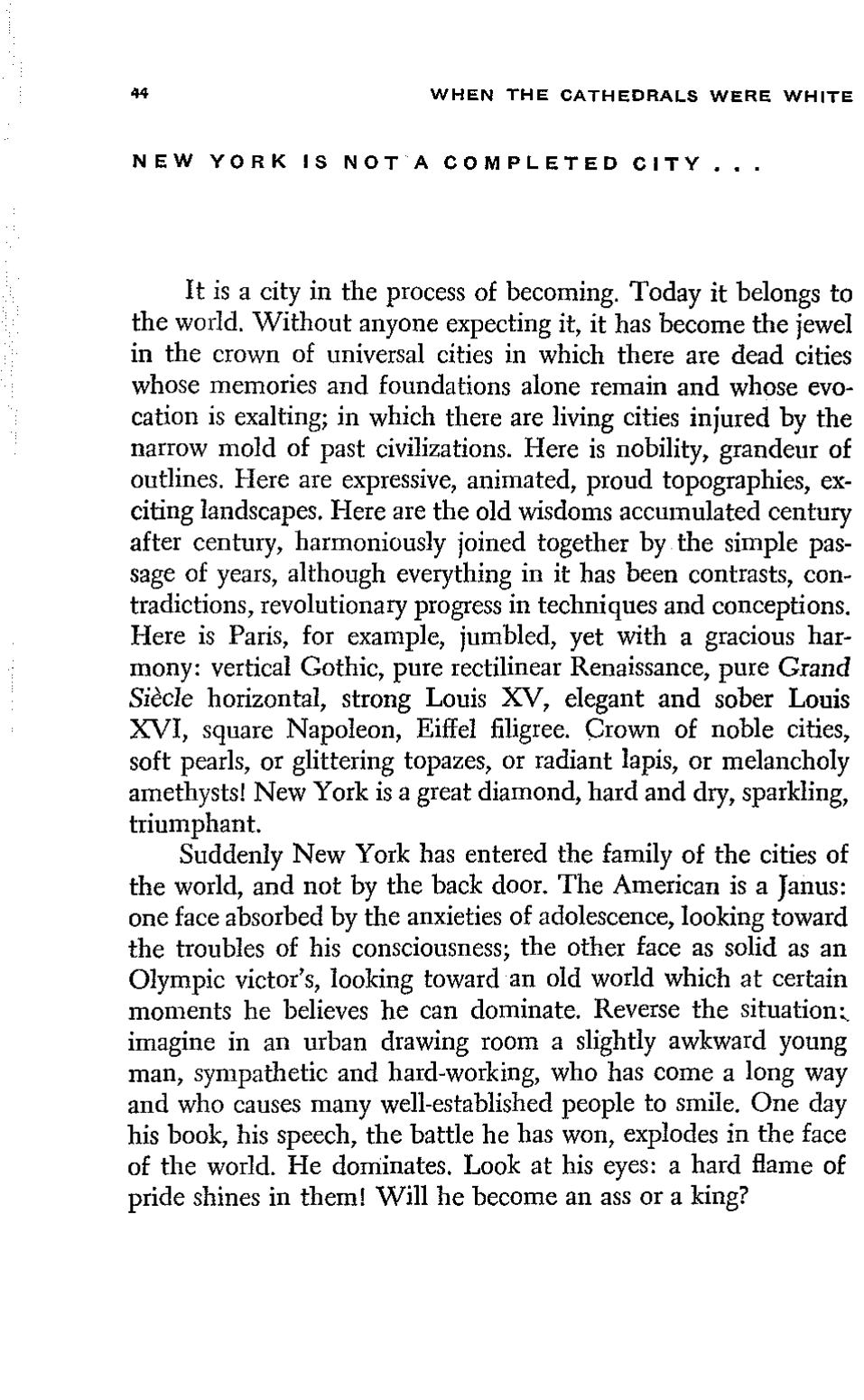 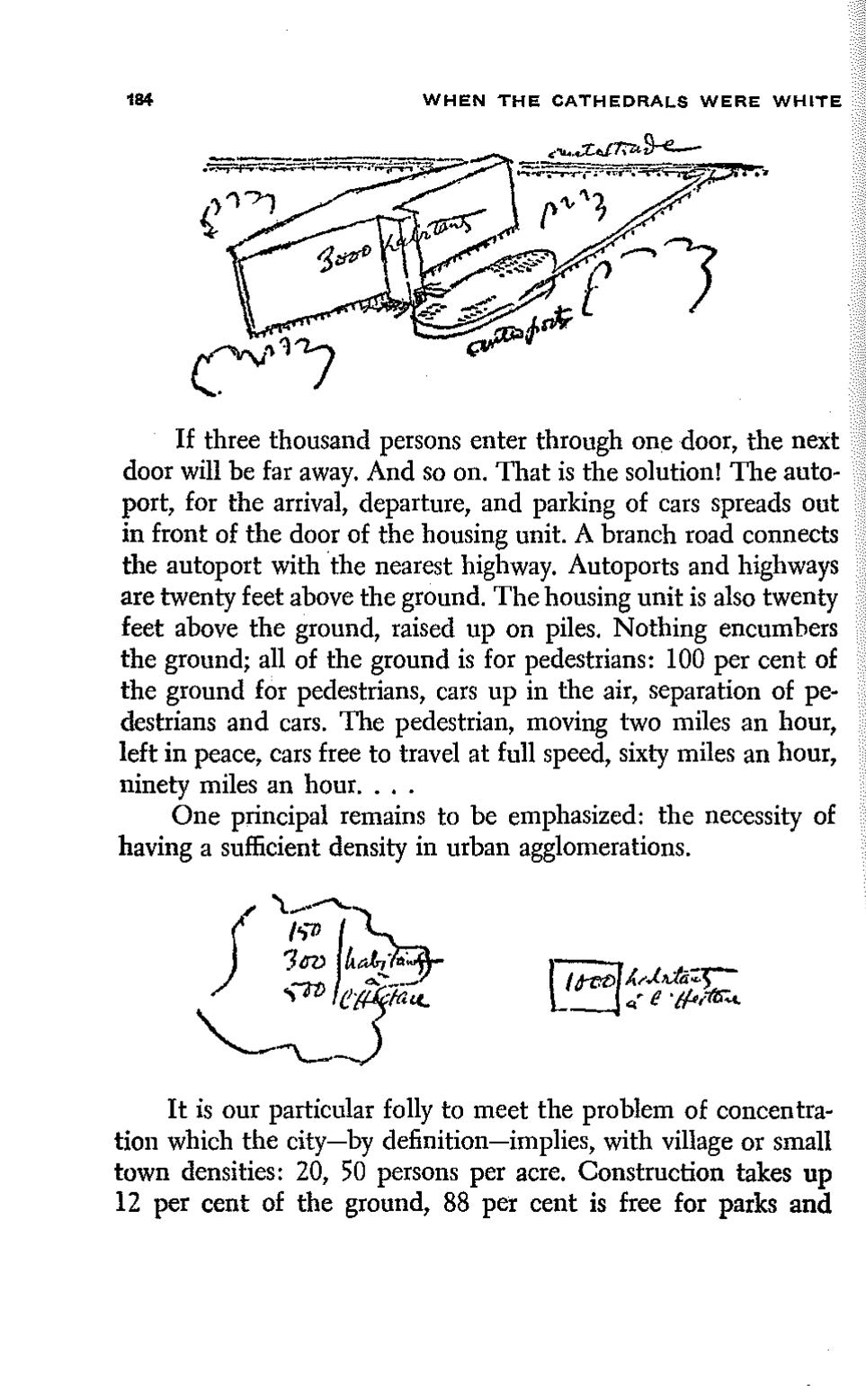
Direct download link (pdf; 7,6 MB).
Все авторские права на данный материал сохраняются за правообладателем. Электронная версия публикуется исключительно для использования в информационных, научных, учебных или культурных целях. Любое коммерческое использование запрещено. В случае возникновения вопросов в сфере авторских прав пишите по адресу 42@tehne.com.
8 сентября 2020, 13:45
0 комментариев
|
Партнёры
|





Комментарии
Добавить комментарий